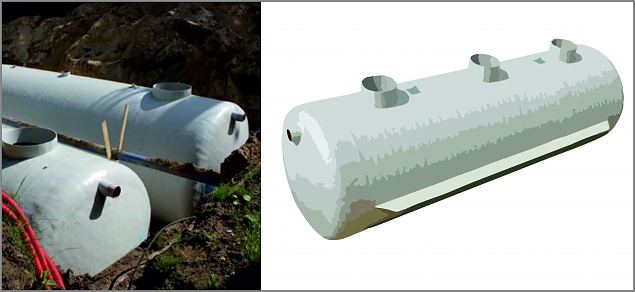 Holding tank Wastewater holding tank is an enclosed container designed to collect and temporarily store wastewater in places where the use of wastewater treatment systems is limited or impossible. Within the frameworks of VillageWaters Project chemical toilets (Portaloo, TOITOI, Honey Bucket etc. ) are considered as storage tanks too, since they do not have output to environment. Wastewater holding tank with filling alarm produced by Scan-Plast Latvia LSEZ SIA ADVANTAGES DISADVANTAGES Low installation cost More frequent content evacuation comparing with septic tanks and active sludge plants No power consumption No reagents used Is possible contamination of close environment No output to close environment Holding tank
Holding tank Wastewater holding tank is an enclosed container designed to collect and temporarily store wastewater in places where the use of wastewater treatment systems is limited or impossible. Within the frameworks of VillageWaters Project chemical toilets (Portaloo, TOITOI, Honey Bucket etc. ) are considered as storage tanks too, since they do not have output to environment. Wastewater holding tank with filling alarm produced by Scan-Plast Latvia LSEZ SIA ADVANTAGES DISADVANTAGES Low installation cost More frequent content evacuation comparing with septic tanks and active sludge plants No power consumption No reagents used Is possible contamination of close environment No output to close environment Holding tank Cleaner water
in your village and aroundHolding tank
Wastewater holding tank is an enclosed container designed to collect and temporarily store wastewater in places where the use of wastewater treatment systems is limited or impossible. Within the frameworks of VillageWaters Project chemical toilets (Portaloo, TOITOI, Honey Bucket etc.) are considered as storage tanks too, since they do not have output to environment.
Main characteristics
|
| ||||||||
VillageWaters Project
VillageWaters suggest most effective wastewater treatment solutions in scattered dwellings households, which use their own, independently operated water purification systems.
Helping Homeowners
Environmentally oriented families and homeowners, who live in scattered dwellings areas, where connecting to larger wastewater plants is not option because rural distances.
Project publications
Information Tool, article base and blog will be linked directly to our website.
See also our Facebook pages

Communication
SYKLI Environmental School of Finland
PL 72, 11101 Riihimäki, Finland
Jari Heiskanen (Chief Web Manager),
phone. +358 50 375 2657,

